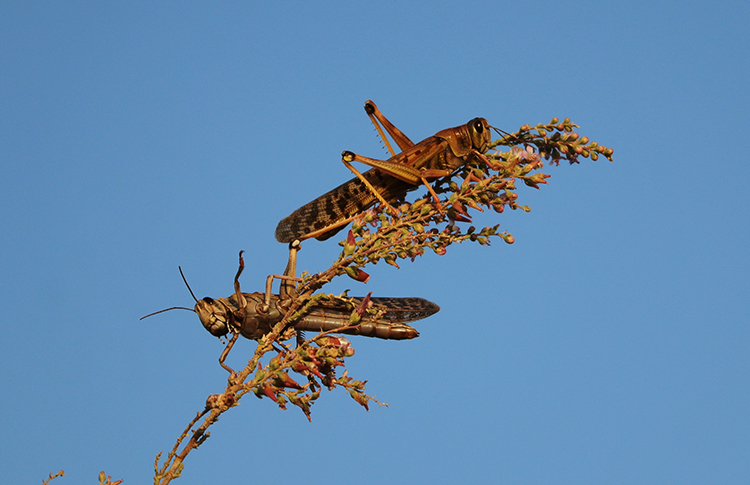
Locust Genome Could Help Find Solutions to Pest's Swarming Behavior
December 9, 2020| |
A team of researchers from the University of Leicester, Ghent University, and the University of Pretoria deciphered the genetic code of desert locust which could provide the basis for developing 'intelligent pesticides' that can act with surgical precision by tapping into locust-specific signals in the nervous system to either kill or disable their swarming behavior without harming other organisms. The crop-devastating behavior of desert locust contributes to the hunger crisis in developing countries.
According to the Food and Agricultural Organization of the United Nations (FAO), a swarm of locusts can contain around 40 million insects per square kilometer, which each day can eat the same amount of food as 35,000 people.
The draft genome is composed of over 8 billion base pairs, making it the largest insect genome ever sequenced and assembled to date. A total of 18,815 protein-encoding genes were found in the genome, and 73% of which were assigned with at least one role based on similarity with characterized proteins.
"We hope that our data can facilitate the development of novel, more sustainable methods of managing swarm outbreaks. With the information in our research now available, there is a unique opportunity for innovators to create an intelligent pesticide that targets locusts, but not other insects crucial to the ecosystem, such as pollinators."," said Dr. Swidbert Ott, one of the authors from the University of Leicester.
For more details, read the article in F1000 research and in New Food Magazine.
| |
You might also like:
- Scientists Decode Locust Genome
- Researchers Look at Biomass Potential of Black Locust Plant
- Locust Disaster in Tanzania Prevented
Biotech Updates is a weekly newsletter of ISAAA, a not-for-profit organization. It is distributed for free to over 22,000 subscribers worldwide to inform them about the key developments in biosciences, especially in biotechnology. Your support will help us in our mission to feed the world with knowledge. You can help by donating as little as $10.
-
See more articles:
-
News from Around the World
- International Study Decodes the Genome of 15 Wheat Varieties
- International Animal Biotech Webinars Wrap Up for 2020
- ISAAA Webinar: Global Status of Biotech Crops and the Philippine Adoption Experience
- Locust Genome Could Help Find Solutions to Pest's Swarming Behavior
- International Research Team Publishes Barley Pan-Genome
- Filipino Researchers Develop Motion Tracker for Eggplant's Most Vicious Pest
- Biotech Maize Area in Vietnam Expands to 92,000 Hectares
- Research Team Discovers Strategy to Make Plants More Salt Tolerant
-
Research Highlights
- Ectopic Expression of a Grape Nitrate Transporter Boosts Nitrogen Use Efficiency in Arabidopsis
- GM Birch Tree Study Shows Promising Results Against Insect Herbivores
-
Plant
- Two Studies Reveal Retron's Function and its Genome-editing Potential
-
Health
- COVID-19 Test Uses CRISPR and Smartphone Camera
-
Read the latest: - Biotech Updates (December 3, 2025)
- Gene Editing Supplement (November 26, 2025)
- Gene Drive Supplement (February 22, 2023)
-
Subscribe to BU: - Share
- Tweet

